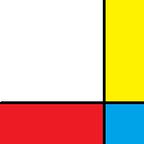Terribilità: Michelangelo di Lodovico Buonarroti Simoni
十六世纪的意大利流传着这么一个单词“Terribilità”,它的意思是:一种引起恐惧、敬畏、或崇高的品质。这个单词如今成为一位著名画家、雕塑家的代名词,他就是米开朗基罗(Michelangelo di Lodovico Buonarroti Simoni)
The word “Terribilità” is circulated in Italy in the sixteenth century, meaning a quality that causes fear, awe, or sublime. The word is now synonymous with a famous painter and sculptor, he is Michelangelo di Lodovico Buonarroti Simoni.
之所以使用“Terribilità”来形容他,一方面是因为他的性格太过于糟糕,以至于无人可以与他打交道,另一方面则是因为他的作品太过于精美和传神,以至于“引起恐惧”。那么这位性格“恐怖”的大师都有哪些“恐怖”的作品呢?
The use of “Terribilità” to describe him is partly because his character is so bad that no one can deal with him, and partly because his work is so exquisite and expressive that it “causes fear” “. So what are the “horror” works of this “horror” master?
这座雕塑又被称为《哀悼基督》或是《圣母怜子像》,也是米开朗基罗唯一署名作品。故事取材于《圣经》,描绘的是圣母抱着被钉死的基督万分悲痛的情景。圣母被描绘为一位少女,米开朗基罗认为“圣母是纯洁、崇高的化身,所以必然能够永远保持青春美丽的容颜”,圣母低着头,注视着圣子,从中能够感受到圣母“哀莫大于心死”的悲痛。
This sculpture is also known as “The Lamentation over the Dead Christ” or “Pietà” and is the only signed work by Michelangelo. The story is based on the Bible and depicts the grief of the Virgin Mary holding the crucified Christ. Virgin Mary is portrayed as a young girl. Michelangelo believes that “Virgin Mary is a pure and noble incarnation, so she must be able to maintain her youthful and beautiful face forever.” Virgin Mary lowered her head and stared at the Son, from which she could feel the sorrow of the Madonna “no more than death.”
这座“大卫”原本是多纳泰罗未完成的半成品,在25年之后,米开朗基罗接受委托对这个棘手的半成品进行改造。他凭借着对人体构造的高度了解,雕刻出了这座“西方美术史上最值得夸耀的男性裸体雕塑”。“大卫”是雕刻家们最喜欢的雕刻主题之一,前文中我们提到的多纳泰罗的大卫描绘的是少年大卫获得胜利,踩着巨人人头的瞬间;而米开朗基罗的大卫所描绘的则是“像神一般”的大卫投石前的紧张时刻,他的身体姿态更像是在休息,但眼神坚定,充满自信。这也是米开朗基罗对于“人”的强调和高度评价,即人也可以像神一样的挺拔、英俊。
This “David” was originally Donatello’s unfinished semi-finished product. After 25 years, Michelangelo was commissioned to transform this semi-finished product. With a high degree of understanding of human body structure, he carved this “most notable male boast sculpture in Western art history”. “David” is one of the sculptors’ favorite carving themes. The David of Donatello we mentioned in the previous article depicts the moment when the young David won the victory and stepped on the head of the giant; Michelangelo David’s depicts a “godlike” moment of tension before David’s stone-throwing. His body posture is more like a rest, but his eyes are firm and confident. This is also Michelangelo’s emphasis on “people” and high evaluation, that is, people can also be tall and handsome like gods.
米开朗基罗对大卫的刻画非常细节,甚至连他手臂上爆出的青筋也雕刻出来了。他甚至考虑到了观者将会仰头欣赏这座雕塑,因而可以将大卫的头比例放大,以让观者仰头观赏时能看到一个比例协调的大卫。
Michelangelo’s portrayal of David is very detailed, and even the green bars bursting out of his arms are carved out. He even considered that the viewer would look up at the sculpture, so he could enlarge the proportion of David’s head so that the viewer could see a harmonious David when he looked up.
米开朗基罗在西斯廷大厅中央绘制了9幅宗教题材的壁画,但这9幅壁画实际上画的是“人”而不是“神”,每幅作品中都可以读出米开朗基罗想要传达的人文思想。故事取材于《圣经》,分别描绘了《神分光暗》、《创造日、月、草木》、《神分水陆》、《创造亚当》、《创造夏娃》、《原罪 — 逐出伊甸园》、《诺亚献祭》、《大洪水》、和《诺亚醉酒》。原本的任务是绘制12个人物,但是当《创世纪》完成后,画面上的人物多达300人。
Michelangelo painted 9 religious murals in the center of the Sistine Hall, but these 9 murals actually painted “human” rather than “god”, and Michelangelo can be read in each work Humanistic thoughts to be conveyed. The story is based on the Bible, which depicts “Divine Divide Light”, “Creation Day, Moon, and Plants”, “Divine Divide Land”, “Creating Adam”, “Creating Eve”, “Original Sin-Eviction from the Garden of Eden”, “ Noah ’s Sacrifice, The Great Flood, and Noah ’s Drunk. The original task was to draw 12 characters, but when “Genesis” was completed, there were as many as 300 figures.
其中最有名的是《创造亚当》,从构图上看,画面的左边是被创造的亚当,右边则是造物主上帝。亚当的身体与上帝的身体等大,像呼应的镜像一样,。亚当躺在一片草地上,上帝则包裹在“大脑”形状的红色裹布里,似乎在暗示:“意识才是以为造物主给予他的造物的真正礼物”。
The most famous one is “The Creation of Adam”. From the composition point of view, the left side of the painting is the created Adam, and the right side is the Creator God. Adam’s body is as large as the body of God, like a mirror image of echoes. Adam was lying on the grass, and God was wrapped in red in the shape of a “brain.” It seemed to imply: “The consciousness is the real gift given to him by the Creator.”
这幅巨型祭坛画是基于《启示录》中描绘的故事,耶稣再临,审判世间善恶灵魂,善者上天堂,恶者下地狱。
This giant altarpiece is based on the story depicted in “Apocalypse”. Jesus comes again, judging the good and evil souls of the world, the good go to heaven, and the evil go to hell.
这是一幅描绘了约400个人物的大型壁画,如何将这些人物合理的安排在画面中呢?米开朗基罗受到了旦丁《神曲》地狱篇的启发,形成了一个以基督为中心的律动类圆形,使得众多的人物和情节得到统一。画面大致可以分为四个部分,最上层是天国的天使,画面中央是耶稣,下方是受裁决的灵魂,最底层则是地狱。他将上方的人物画的大些,下方的人物画的小些,以解决观者从下仰视这副壁画时比例不对的问题。
This is a large mural depicting about 400 people. So how to arrange these characters in the picture reasonably? Michelangelo was inspired by the hell chapter of Dante’s Divine, forming a rhythm-like circle centered on Christ, making many characters and plots unified. The picture can be roughly divided into four parts. The uppermost layer is the angel of heaven, Jesus is at the center of the picture, the ruling soul is below, and the bottom is hell. He draws the figure above larger and the figure below smaller, to solve the problem of incorrect proportions when the viewer looks up at the mural from below.
画中的耶稣,神态威严,一反圣经中救世主的模样,一度引得罗马城为之倾倒。为了体现以“人”为中心的人文思想,米开朗基罗大胆地将画中的人物画为裸体,但教皇保罗四世认为裸体亵渎神灵于是下令给所有裸体认为画上衣饰,这群受命的画家也被戏虐为“内裤制造商”。
Jesus in the painting with a majestic look, contrary to the appearance of the savior in the Bible, once caused the city of Rome to fall over. In order to embody the human thought centered on “people”, Michelangelo boldly painted the figures in the painting as nudes, but Pope Paul IV believed that the nudes blasphemed the gods, so he ordered all the nudes to be considered to be decorated with clothes. The painter was also commented scholarly with an interesting name an “underwear manufacturer”.
